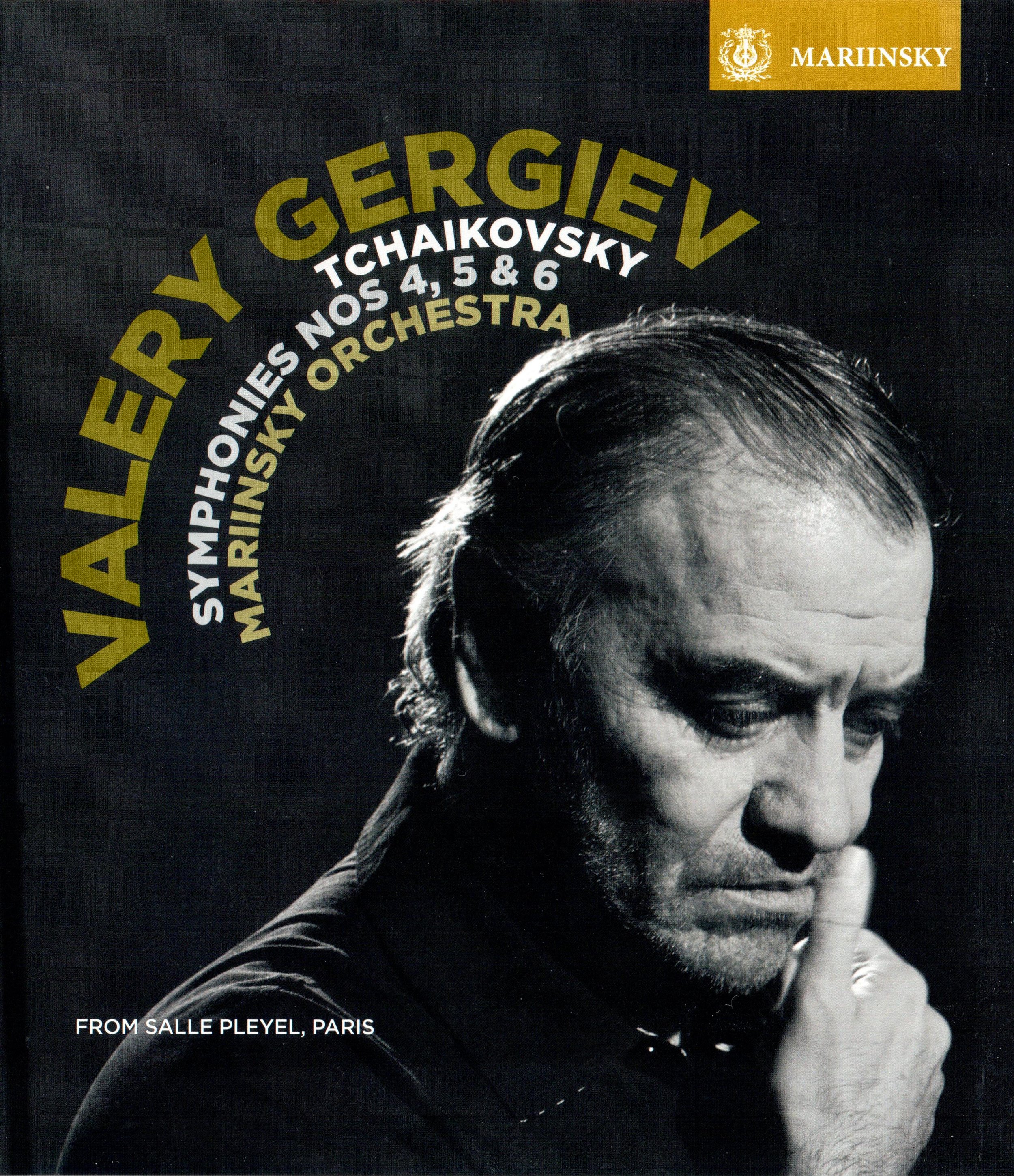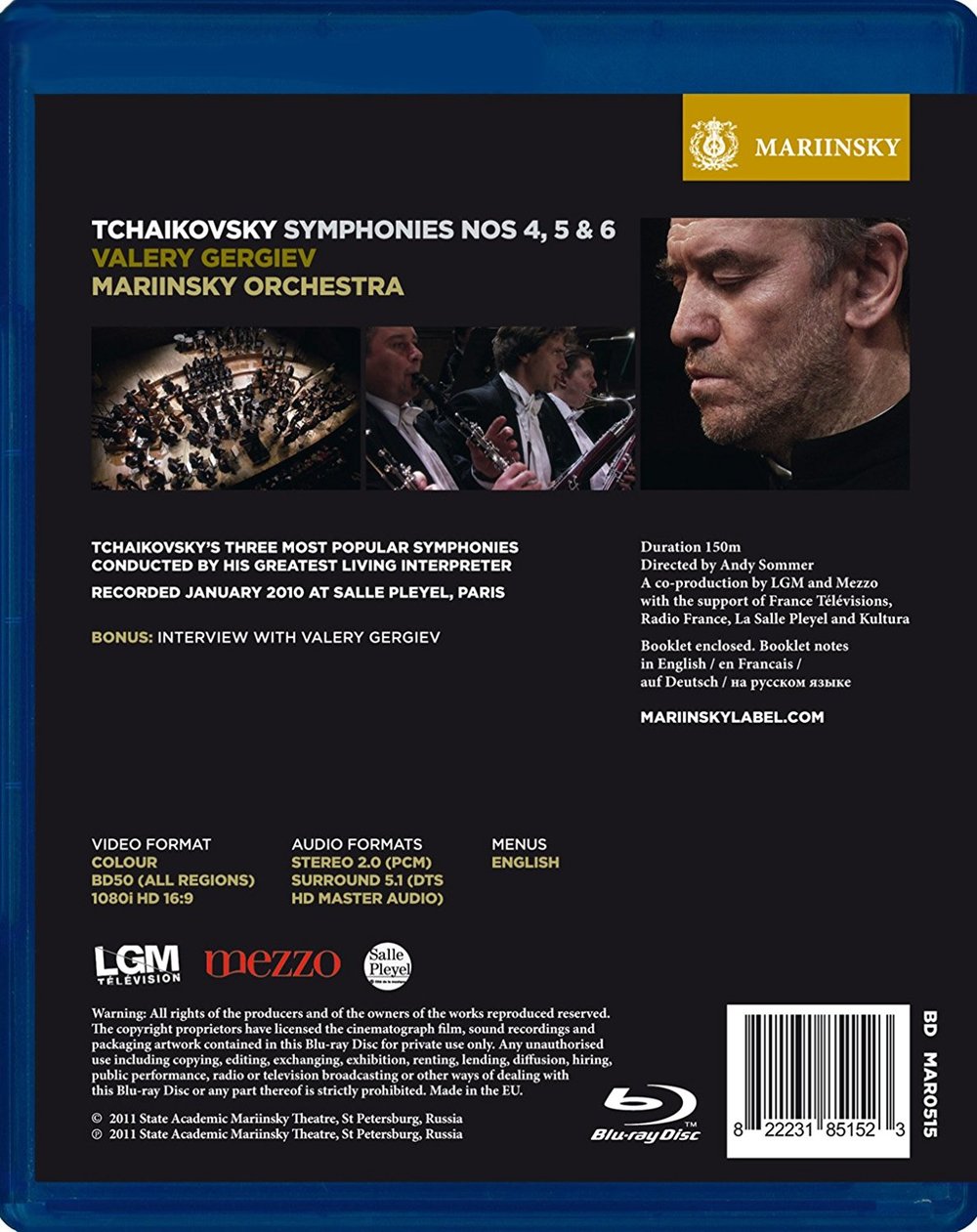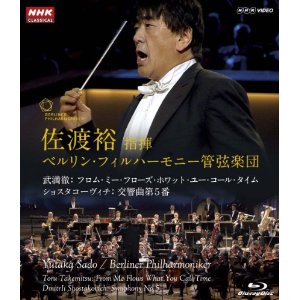Bach St. Matthew Passion oratorio recorded live 2012 at the St. Thomas Church in Leipzig. Georg Christoph Biller conducts the Thomanerchor Leipzig and the Gewandhausorchester Leipzig (the Leipzig St. Thomas Boys Choir and the Gewandhaus Orchestra). Soloists are Christina Landshamer (soprano), Stefan Kahle (alto), Wolfram Lattke (tenor), Martin Lattke (tenor), Klaus Mertens (bass), and Gotthold Schwarz (bass). Directed for TV by Michaes Beyer; produced by Paul Smaczny. Released 2012, disc has dts-HD Master Audio sound. Grade: NA
Concert
Berliner Philharmoniker 3D in Singapore
Berliner Philharmoniker 3D in Singapore concert. Simon Rattle conducts the Berliner Philharmoniker in the Rachmaninov Symphonic Dances and Mahler Symphony No. 1. This was shot in Singapore in 3D for the Japanese market. The package has practically nothing in English except the title. But we can report that the sound was recorded with 48 kHz/24 bit sampling. The video was shot at 23.976 Hz, which is the speed for motion picture film. This title plays fine on a 2D display. On our new 3D player, it plays in 3D. But we can use a toggle on the TV remote control to switch to 2D. Released 2011, we understand this title is restricted to Region A and has 5.1 PCM sound output. 2D Grade: C- 3D Grade: D
Mozart Chamber Music (2D/3D)
Mozart Chamber Music. Performed by The Old City String Quartet: Bryan Lee, violin; Joel Link, violin; Milena Pajaro-van de Stadt, viola; and Camden Shaw, cello. (The name of the group was later changed to the Dover Quartet.) Special appearances by Corey Klein on horn and Ruokai Chen on clarinet.
Here's the program:
Clarinet Quintet in A Major, K. 581
String Quartet, K. 169
Horn Quintet in E-flat Major, K. 407
Directed and produced by Mark Waldrep. Presented in 2D and 3D, but the menu doesn't give you a choice of dimensions. If your set up is just 2D, it plays as usual. If you have a 3D set up, you get 3D. If you have a 3D set up but want to see the 2D presentation, you start with 3D, and then switch to 2D as permitted by your gear. (Another way would be to enter the menu, go to video set up, and turn off 3D.) We will review this as a 2D disc that everyone can enjoy.
This title has 53 minutes of music. The audio was recorded with 96 kHz/24-bit sampling, mixed in a 5.1 Dolby TrueHD "Stage" mix, a 5.1 Dolby TrueHD "Audience" mix, and a 5.1 Dolby Digital mix (as well as stereo). Grade: A+ for 2D only.
Read MoreSan Francisco Symphony at 100
San Francisco Symphony at 100 concert. Michael Tilson Thomas conducts the San Francisco Symphony in a gala concert in honor of the San Francisco Symphony's first centenary. The concert portion of program has 75 minutes of music as follows:
Aaron Copland - Billy the Kid Ballet Suite
Felix Mendelssohn - Violin Concerto in E minor (Itzhak Perlman)
Benjamin Britten - The Young Person's Guide to the Orchestra
John Adams - Short Ride in a Fast Machine
Also included is a 58-minute documentary narrated by Amy Tan about the history of the San Francisco Symphony. Directed for TV by Gary Halvorson; audio direction by Jack Vad. This disc is self-published by the San Francisco Symphony on the SFSmedia label. It has an "ALL" region logo on the back of the keep case.
St. Matthew Passion
Bach St. Matthew Passion oratorio. Ritualised (directed) 2010 by Peter Sellers at the Philharmonie in Berlin. Stars tenor Mark Padmore (Evangelist or John the Baptist), bass Christian Gerhaher (Jesus), soprano Camilla Tilling, contralto Magdalena Kozena, tenor Topi Lehtipuu, and bass Thomas Quasthoff (recitatives and arias), Jörg Schneider (Judas), Sören von Billerbeck (Peter), Axel Scheidig (Pontius Pilate), Christine Lichtenberg (1st Witness), Holgar Marks (2nd Witness), David Stingl (1st High Priest), Thomas Pfützner (2nd High Priest), Isabelle Voßkühler (1st Maiden), Christina Bischoff )(2nd Maiden), and Barbara Kind (Wife of Pontius Pilate). Sir Simon Rattle conducts the Berliner Philharmoniker, the Rundfunkchor Berlin (Chorus Master Simon Halsey), and the Knaben des Staats und Domchors Berlin (Chorus Master Kai-Kwe Jirka). Music has runtime of 195 minutes and there is a 51-minute bonus extra with Peter Sellers in conversation with Simon Halsey. Directed for TV by Daniel Finkerhagel and Alexander Lück. Released 2012, disc has 5.1 dts-HD Master Audio sound. Luxury package also has 2 DVDs and other extra features. Grade: NA
Salzburg Festival Opening Concert 2011
The 2011 Opening Concert for the Salzburg Festival consists of:
Berg Der Wein
Berg Lulu Suite
Mahler Das Klagende Lied
Pierre Boulez conducts the Vienna Philharmonic Orchestra and the Concert Chorus of the Vienna State Opera (Chorus Master Jörn H. Andresen). Soloists are Dorothea Röschmann (soprano), Anna Prohaska (soprano), Anna Larsson (contralto), and Johan Botha (tenor). Directed for TV by Michael Beyer. Released 2012, disc has 5.1 dts-HD Master Audio sound. Grade: NA
Bach Mass in B minor and Beethoven Symphony No. 5
Bach Mass in B minor and Beethoven Symphony No. 5 concert. This title has two segments:
Segment 1 was recorded in 2005:
Bach Mass in B minor. Herbert Blomstedt conducts the Gewandhausorchester Leipzig and the GewandhausKammerchor Leipzig (Chorus Master Morten Schuld-Jensen) at the 2005 Leipzig Bach Festival. Soloists are Ruth Ziesak (soprano), Anna Larsson (contralto), Christoph Genz (tenor), and Dietrich Henschel (bass). Includes a bonus film Bach and his B minor Mass with Herbert Blomstedt. This segment was directed for TV by Michael Beyer and produced by Paul Smaczny.
Segment 2 was recorded in 1999 in Leipzig:
1. Bach Toccata & Fugue in D minor (Jürgen Wolf organ)
2. Bach Motet "Fürchte dich nicht" (Thomaner Chor with Chorus Master George Christoph Biller)
3. Bach Partita for solo violin No. 2 in D minor "Chaconne" (Victoria Mullova violin)
4. Mendelssohn Elias Op. 70 "Höre Israel" (Gewandhausorchester and Nancy Argenta soprano)
5. Mendelssohn "Fürchte dich nicht" from Elias (Gewandhausorchester and GewandhausKammerchor)
6. Beethoven Symphony No. 5. (Gewandhausorchester)
7. Bach Mass in B Minor "Dona Nobis Pacem" (Gewandhausorchester, GewandhausKammerchor, and Thomaner Chor)
Segment 2 was directed for TV by Bob Coles and produced by Paul Smaczny with Isabel Iturriagagoilita. Released 2012, has 5.1 dts-HD Master Audio sound. Grade: NA
Nobuyuki Tsujii Carnegie Hall Debut
The Nobuyuki Tsujii Carnegie Hall Debut Live solo piano concert was performed on November 10, 2011. This disc came out promptly in early 2012 for the Japanese market. For more comments about this concert, screenshots, and a the grade of A-, see the EuroArts version of this title.
Brahms Symphony No. 1, Dvořák Symphony No. 9, Sibelius Symphony No. 5, Nielsen Symphony No. 3
Here's the program:
Brahms Symphony No. 1
Dvořák Symphony No. 9 "New World"
Sibelius Symphony No. 5
Nielsen Symphony No. 3 "Sinfonia Espansiva"
Thomas Dausgaard conducts the Danish National Symphony Orchestra at the Koncerthuset in Copenhagen. Also features interviews with Dausgaard. Head of TV Project was Søren Therkelsen; Video Directors were Arne J. Rasmussen and Uffe Borgtardt; Sound Producer was Preben Iwan; Sound Engineer was Jan Oldrup. Released 2012, disc has 5.1 dts-HD Master Audio sound. Grade: NA
Chopin Piano Concertos 1 & 2
Chopin Piano Concertos 1 & 2 concert played by Daniel Barenboim at the 2010 Ruhr Piano Festival with the Staatskapelle Berlin conducted by Andris Nelsons. Barenboim plays the Chopin Valse brillante in A Minor as encore. Also includes a performance of the Haydn Symphony in E minor ("Mourning") by the Staatskapelle Berlin and Nelsons. Directed for TV by Enrique Sánchez Lansch; director of photography was Nyika Jancsó; produced by Paul Smaczny. Released 2011, disc has 5.1 dts-HD Master Audio sound. Grade: D+
Beethoven Piano Concerto No. 5 and Scheherazade
Beethoven Piano Concerto No. 5 and Rimsky-Korsakov Scheherazade. Andris Nelsons conducts the Royal Concertgebouw Orchestra at the 2011 Lucerne Festival. Solo pianist is Yefim Bronfman. This disc features the following selections:
Beethoven The Ruins of Athens Overture
Beethoven Piano Concerto No. 5 "Emperor"
Chopin Etude Op. 10 No. 8 in F major
Rimsky-Korsakov Scheherzade
Dvorak Slavonic Dance No. 3
Directed for TV by Ute Feudel; Director of Photography was Nyika Jancsó; produced by Maria Stodtmeier (Accentus), Magdalena Herbst (Unitel), and Paul Smaczny (Accentus). Released 2012, disc has 5.1 dts-HD Master Audio sound. Grade: NA
Shostakovich Symphony No. 8
Shostakovich Symphony No. 8. Andris Nelsons conducts the Royal Concertgebouw Orchestra at the 2011 Lucerne Festival. The program is:
Richard Wagner Rienzi: Overture
Richard Strauss Salome: Dance of the Seven Veils
Dmitri Shosakovich Symphony No. 8
Directed for TV by Ute Feudel; Director of Photography was Nyika Jancsó; produced by Maria Stodtmeier (Accentus), Magdalena Herbst (Unitel), and Paul Smaczny (Accentus). Released 2012, disc has 5.1 dts HD Master Audio sound. Grade: NA
Tchaikovsky Symphonies Nos. 4-6


Tchaikovsky Symphonies Nos. 4-6. Valery Gergiev conducts the Mariinsky Orchestra in 2010 at Salle Pleyel in Paris. Three separate performances were directed for TV by Andy Sommer. Released 2011, disc has 5.1 dts-HD Master Audio sound. For all three tites: Grade: F
The musical performances at Salle Pleyel were probably quite enjoyable to the audience. But the SQ of the recording is poor compared to other HDVDs we have of the Tchaikovsky Symphony No. 6. Still, it's the video that tanks all three performances on this disc. I'll first describe in some detail the video recording of S4. The videos for S5 and S6 are similar with some differences I'll mention.
Tchaikovsky S4
The PQ of this Tchaikovsky S4 is almost astonishingly bad considering the fact that it was recorded in 2010. My theory is that the light at Salle Pleyel presented challenges the technicians could not overcome. Resolution is soft. Most frames are over-exposed, and the color balance is weirdly off with rose and yellow tones dominating. There is glare everywhere from the metal parts of instruments, the sheet music, and the white shirts. A white fog rises from the bottom of the picture from time to time. Many of the shots of the conductor have irritating motion artifacts. Many shots are plagued with focus and depth-of-focus issues.
Picture content is even worse than PQ because this video suffers from DVDitis with a wicked twist.
DVDitis is an illness that occurs when an HDVD is shot by folks who are used to making DVDs but don't know how to use high-definition TV cameras to make an HDVD. The main symptoms of DVDitis are lots of conductor shots used as a "hub" with many (easy-to-make) "spoke" shots of solo players, small groups of players, and instrument-only views, often in extreme close ups. In contrast to this, an HDVD with its high-definition pictures can present enjoyable views of large sections and especially the whole orchestra. (See our special article on standards for making a good HDVD of a symphony orchestra.)
The wicked twist here is that the Salle Pleyel supports a "spy cam" or mobile camera (probably on a wire) that looks down on the orchestra. This might sound like a useful capability. But as explained below, the spy cam just interferes with our enjoyment of the symphony.
The individual shots in this video are almost all very short. By the time the viewer gets oriented and is ready to enjoy a frame, a cut interferes and forces the viewer to focus on the next segment. There are no fewer that 73 conductor shots as the "hub" in this title. Then comes 53 instrument-only shots. There are 261 shots in the whole video. So already 48% of the video is accounted for without showing a player. Most of the rest of the video consists of shots of solos and small groups that can be done with close ups that look good on DVD. There are only 15 shots of whole sections and 15 shots of major parts of the orchestra.
That leaves us with about 20 whole orchestra shots. Of these, only 6 are traditional front-view, longer-range frames. The other 14 were made with the spy cam. When you see the whole orchestra from a seat in a theater, the group appears to be close together. When you see this from above with a spy cam, you realize that the orchestra a quite spread out. You are probably not used to this. The result is mental confusion and the need for time to get the images firmly in mind so you can observe and understand what you are seeing. But hold the phone! Already the spy cam is moving about or zooming in or out, which further interferes with your efforts to grasp what is happening.
The result of all this is that I found it wearisome to have to watch this Tchaikovsky S4. Still, to be fair, I did note some good shots. See 7:05 for a nice view of the bass violins and the 1st violins. I also liked a shot of the trombones and tuba at 9:28 and two traditional shots of the entire horn section at 18:24 and !8:39. There were two good spy cam shots of the cellos and winds at 9:25 and 9:36. But on the other hand, see the totally inane spy cam shot at 9:02 looking straight down on the tops of heads of a group of strings.
Tchaikovsky S5
For this title, the color balance was grayed down to a "sepia" look, possibly in a (substantially unsuccessful) effort to get rid of glare. I get the impression management was fiddling with the lights, and that the result was even more "hot spots" than before.
Tchaikovsky S6
Yet another change in color balance provides a "blue light" on the orchestra. Most other color is drained out. This may reduce glare a bit and resolution appears to be improved. But the musicians now all look quite grim—like characters in a horror movie where the "undead" play a symphony for an audience of seated frozen corpses. (See 1:51:47 for the corpses.) At 2:09:57 there is something new—a freeze frame of Gergiev's face. See 2:22:01 to 2:22:04 for a short segment where nothing is in focus. Finally, for maybe the worst shot ever published on an HDVD, see between 2:13:32 and 2:13:33. A camera was left on for a split-second while it was turned to the next subject in the shooting plan. You see 22 smeared shots (22 of 30 frames in a second) before the camera stops. This is a "blooper" rather than a weak shot. It should have been caught by the editor or later by whoever is in charge of quality control at Mariinsky.
Now for a grade: for weak sound, we go from an A+ to B. For bad PQ and video content, we drop from B to D. Finally, the poorly deployed spy cam and lack of quality control by Mariinsky leaves us with an F—this disc should have been abandoned and not sold to the public.
Below is a high-quality YT clip that clearly shows the DVD-like video content of this disc. However, the clip does not reveal the PQ issues I raise. But I have seen this title on 3 different high quality HT displays displays. Somehow the publisher managed to clean up the video on the YouTube segment, which I consider to be something like false advertisement. I wish the Blu-ray recording had been made with the same degree of care as this official clip:
OR
Music Is the Language of the Heart and Soul: A Portrait of Mariss Jansons and Mahler Symphony No. 2
Music Is the Language of the Heart and Soul: A Portrait of Mariss Jansons and Mahler Symphony No. 2. Here's the content:
1. Portrait of Mariss Jansons. Documentary by film maker Robert Neumüller on the life and career of Mariss Jansons. Produced by Felix Breisach; camera by Robert Neumüller.
2. Mahler Symphony No. 2 with Jansons conducting the Concertgebouw Orchestra and the Netherlands Radio Choir in 2009 in Amsterdam. Ricarda Merbeth sings soprano and Bernarda Fink is the mezzo-soprano. Directed for TV by Joost Honselaar; camera by Marlies Puijk; lighting by Pascal Naber; sound by Everett Porter; edited by Ronald be Beer; produced by Ronald Kok.
Released 2012, the documentary has stereo and the concert has 5.0 dts-HD Master Audio sound. Grade: C-
Takemitsu From me flows what you call time and Shostakovitch Symphony No. 5

Takemitsu From me flows what you call time and Shostakovitch Symphony No. 5. Yutaka Sado conducts his debut with the Berliner Philharmoniker in 2011 at the Berlin Philharmonie. The Takemitsu piece features the entire percussion section of the Philharmoniker: Raphael Haeger, Simon Rössler, Franz Schindlbeck, and Jan Schlichte with Wieland Welzel (one of the timpani players). Directed for TV by Michael Beyer; produced by Grete Liffers. This disc may be restricted to Region A. Released 2011, disc has 5.1 dts-HD Master Audio sound. Grade: B+ for the Takemitsu Grade: C+ for the Shostakovich
This was a special performance to raise relief funds for the people of Japan following the earthquakes and tsunami of March 2011. We already published a review of the EuroArts version of this title, and the grades shown here come from EuroArts review. Please refer to that review for more information.
This Japanese market version of the title appears from product descriptions on the Internet to have exactly the same music as that published by Euroarts. The difference would be, of course, other artwork and package information written in Japanese. It also appears that the sound on this recording, while excellent by general consumer standards, was not recorded with 96kHz/24 bit technology that is often used by NHK. So this would not be one of the audiophile recordings we have been enjoying from NHK.
Purchase from Amazon Japan.
